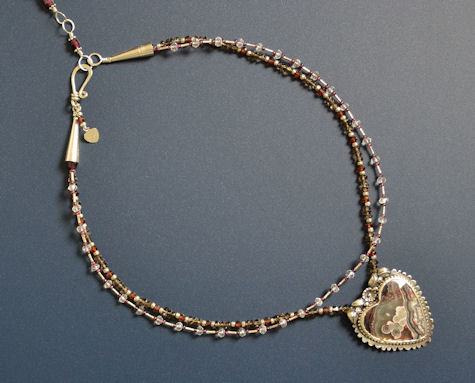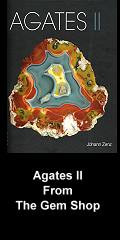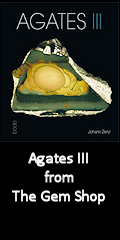Another crazy lace agate for your pleasure! While every stone is my favorite, I have a special fondness for crazy lace. This one has fabulous patterns in fairly neutral colors (with a spark of red!) that will complement almost any outfit. The necklace is quite delicate and feminine with its tiny garnets, smoky topaz (which is actually quartz, not topaz) and tiny silver beads.
The word 'garnet' comes from the Latin granatum, 'pomegranate.' The pomegranate symbolizes fertility and abundance. According to The Book of Stones, garnets were used as far back as the Bronze Age in the area of Czechoslovakia, and in Egypt more than 5,000 years ago. Simmons says the Talmud mentions that the only light on Noah's ark was provided by a large garnet. I spent quite a bit of time trying to verify this claim but was unable to do so. It's a great story, if any Talmudic scholar can assist me in finding the details I will credit you here!
The garnets in this necklace are most likely rhodolite, which Simmons says combines the energies of the base chakra, heart chakra and crown chakra. How perfect to complement the heart-shaped centerpiece!
Bourgault notes that garnet is unusual in that it is almost inactive if it has not been cut and polished. He states that garnet enables one to work when the crack between the worlds is open. His book is well worth considering as it provides a Native American perspective on the therapeutic use of crystals. By the way, his concern, and that of the elders who have taught him and have given their permission to publish his work, is to rectify what they perceive as dangerous errors in working with crystals which have been promulgated by others.
Do you index the books you read? Scranton's The Science of the Dogon (below) already has a good index, but he missed a few things like "heart" when he wrote it. I sympathize! I have indexed my teacher's books and know how easy it is to fail to index something important. So, when it came time to write this little essay, I was glad I put some references to "heart" in the index myself because he offers a fascinating quote from Wallis Budge, "[One] version [of the creation story] speaks of a heart-soul as assisting Khepera in his first creative acts; and we may assume that he thought out in his heart what manner of thing he wished to create, then by uttering its name caused his thought to take concrete form. This process [he should have said 'activity' not 'process'] of thinking out the existence of things is expressed in Egyptian by the words which mean 'laying the foundation in the heart.'" "Laying the foundation in the heart"... what a beautiful image of the biblical vision that "God is love" [1 Jn 4:8, 16].
The Heartmath book claims there are the same number of neurons in our heart as in our brain, but in the cerebral West, we more often rely entirely upon the calculative mind, completely ignoring the heart. Do we need to be reminded of the consequences of our reliance upon calculative thinking alone by listing the horrors we have invented? Einstein said, "The significant problems we face cannot be solved at the same level of thinking that created them." Heidegger complained, "The most thought-provoking thing in our thought-provoking time is that we are still not thinking" and observing, "Thinking begins only when we have come to know that reason, glorified for centuries, is the stiff-necked adversary of thought." My goodness, this is a philosopher talking! In the face of the Creator's "thinking out the existence of things" Heidegger returned to the Presocratics because "to the early Greeks, being, unlimited in its dis-closure, appears as an abyss, the source of thought and wonder. Being calls everything into question, casts the human being out of any habitual ground, and opens before him the mystery of existence." http://www.iep.utm.edu/heidegge/
What sort of a world might we have if we ourselves found a balance between head and heart instead of relying upon the calculative mind alone? Perhaps wearing this little heart set might provide a gentle reminder that there is another way.









